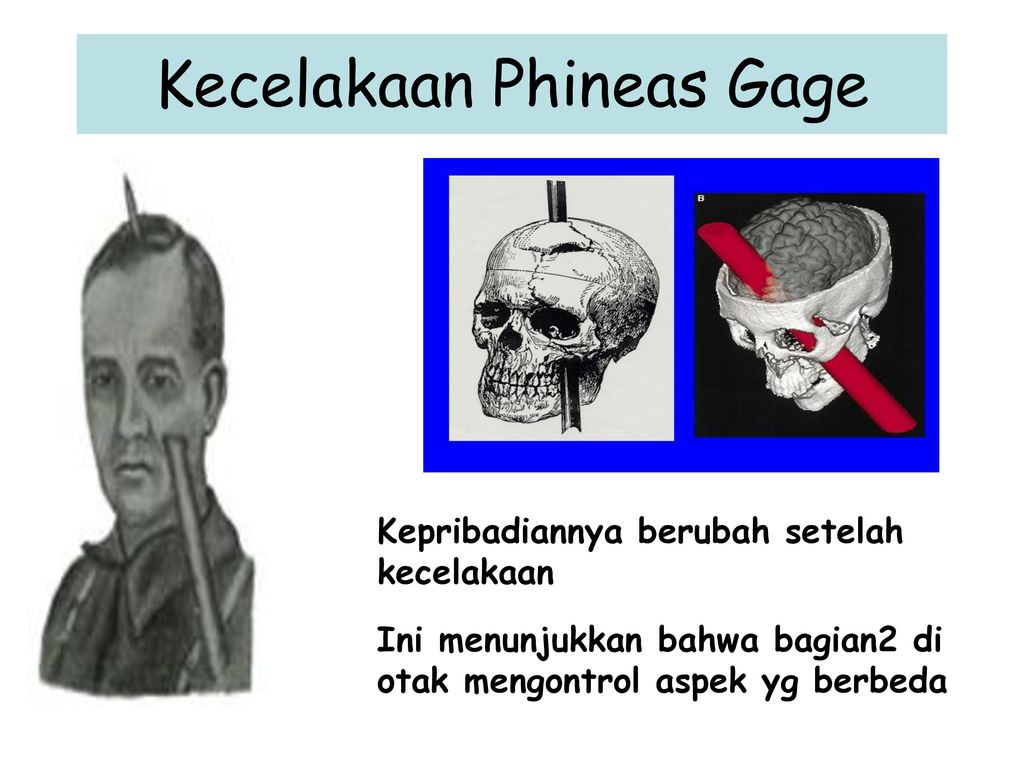Psychology phineas gage
The University of Akron, Ohio
Phineas Gage is probably the most famous person to have survived severe damage to the brain. He is also the first patient from whom we learned something about the relation between personality and the function of the front parts of the brain.
As the first newspaper account of the accident reported, that appearing in the Free Soil Union (Ludlow, Vermont) the day after the accident, and here reproduced as it appeared in the Boston Post, Phineas Gage was the foreman of a railway construction gang working for the contractors preparing the bed for the Rutland and Burlington Rail Road near Cavendish, Vermont. On 13th. September 1848, an accidental explosion of a charge he had set blew his tamping iron through his head
The tamping iron was 3 feet 7 inches long and weighed 13 1/2 pounds. It was 1 1/4 inches in diameter at one end (not circumference as in the newspaper report) and tapered over a distance of about 1-foot to a diameter of 1/4 inch at the other. The tamping iron went in point first under his left cheek bone and completely out through the top of his head, landing about 25 to 30 yards behind him. Phineas was knocked over but may not have lost consciousness even though most of the front part of the left side of his brain was destroyed. Dr. John Martyn Harlow, the young physician of Cavendish, treated him with such success that he returned home to Lebanon, New Hampshire 10 weeks later.
Some months after the accident, probably in about the middle of 1849, Phineas felt strong enough to resume work. But because his personality had changed so much, the contractors who had employed him would not give him his place again. Before the accident he had been their most capable and efficient foreman, one with a well-balanced mind, and who was looked on as a shrewd smart business man. He was now, Harlow said, fitful, irreverent, and grossly profane, showing little deference for his fellows. He was also impatient and obstinate, yet capricious and vacillating, unable to settle on any of the plans he devised for future action. His friends said he was "No longer Gage."
His friends said he was "No longer Gage."
However, although Phineas had a varied employment history, he did hold a number of responsible positions during it. According to Dr. Harlow, Phineas appeared at Barnum's American Museum in New York City, worked in Jonathan Currier’s livery stable at the Dartmouth Hotel (Hanover, NH), and drove coaches and cared for horses in Valparaiso, Chile. In about 1859, after his health began to fail, he went to San Francisco to live with his family who had moved there from Lebanon (NH) at the beginning of the gold-rush. After Phineas regained his health he was anxious to work and found it on a farm in Santa Clara County, south of San Francisco. In February 1860, he began to have epileptic seizures and, as we know from the Funeral Director's and cemetery interment records, he was buried on 23rd May 1860. (Although Harlow gives the year as 1861, the records show conclusively that it was 1860. Here, as elsewhere I have silently corrected Harlow's dates).
Here is the tamping iron and the inscription (corrected since the publication of my book An Odd Kind of Fame: Stories of Phineas Gage).
This is the bar that was shot through the head of Mr. Phinehas P. Gage at Cavendish, Vermont, Sept. 14, 1848. He fully recovered from the injury & deposited this bar in the Museum of the Medical College of Harvard University. Phinehas P. Gage Lebanon Grafton Cy N-H Jan 6 1850
Warren Anatomical Museum records discovered by Dominic Hall of the Countway Library since my book was published show that Phineas himself originally deposited the tamping iron in the Harvard Medical School Museum and asked for it to be returned in 1854. Consequently, it now seems unlikely that Henry Jacob Bigelow, the Professor of Surgery at Harvard’s Medical School, was solely responsible for the inscription and the errors over the spelling of Phineas' first name and the date in it.
It also means that the tamping iron could not have been, as Dr. Harlow said, “his constant companion during the remainder of his life.”
Harlow said, “his constant companion during the remainder of his life.”
What I have summarised is almost all of what Harlow tells us about Phineas Gage. The slightness of what he tells us seems to have encouraged the attribution to Gage of all sorts of fabulous psychological characteristics and an equally fabulous post-accident history. Evidently most of those who have written about Gage have not read Harlow's 1868 report in which what little we know of Gage's last 11 1/2 years are set out. This is not surprising given that neither the Proceedings of the Massachusetts Medical Society nor Harlow's 1869 pamphlet version of his address are held in many of the world's libraries.
Most of the accounts of Gage's life after 1848 are strange mixtures of slight fact, considerable fancy and downright fabrication. Harlow says, for example, that Phineas exhibited himself in the larger New England towns and was with Barnum's American Museum in New York City for a time. These remarks are frequently elaborated into a Gage who drifts around aimlessly and is not interested in working or, if interested, is incapable of holding a job. During the same period, Phineas is often pictured as exhibiting himself, usually as a freak, in circuses or fairgrounds around the country. Part of this fancy comes from Barnum now most often being remembered as the proprietor of a circus rather than the owner of Barnum’s American
Museum in New York to which Harlow unmistakably refers. Similarly, these stories turn Gage into a fairground freak because it is in such places that freaks are or were once seen.
During the same period, Phineas is often pictured as exhibiting himself, usually as a freak, in circuses or fairgrounds around the country. Part of this fancy comes from Barnum now most often being remembered as the proprietor of a circus rather than the owner of Barnum’s American
Museum in New York to which Harlow unmistakably refers. Similarly, these stories turn Gage into a fairground freak because it is in such places that freaks are or were once seen.
In fact, from early in 1851 until just before he died nine years later, Gage seems to have worked at the one occupation, although in two places: in Currier's livery stable and coach business at the Dartmouth Inn for 1 1/2 years, and in Chile in a similar capacity for nearly seven more. There we know he drove stage coaches. Before then we know he was barely well enough to do a full day's work on his parent's farm until June of 1849, just well enough to travel to Boston in November of that year, and was still described in 1850 as failing in bodily powers.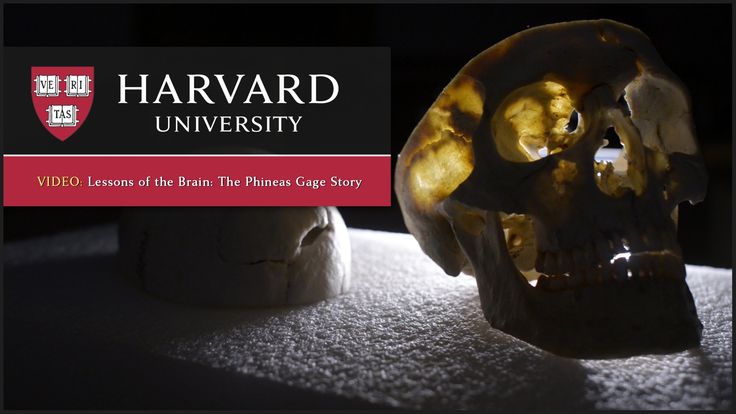 Hence, the maximum time he could have travelled around New England or been with Barnum's Museum would seem to have been about a year. We know nothing about the quality of his work for Currier or that in Chile, or to what extent he was able to support himself. This has not prevented the fabrication of employment histories somewhat at variance with one another: for example, in one he is totally aimless, in another he makes a lot of money from exhibiting himself but dies penniless in an institution. No one notices that his mother said he was anxious to work after he recovered his health in 1859.
Hence, the maximum time he could have travelled around New England or been with Barnum's Museum would seem to have been about a year. We know nothing about the quality of his work for Currier or that in Chile, or to what extent he was able to support himself. This has not prevented the fabrication of employment histories somewhat at variance with one another: for example, in one he is totally aimless, in another he makes a lot of money from exhibiting himself but dies penniless in an institution. No one notices that his mother said he was anxious to work after he recovered his health in 1859.
Similarly, Gage's mother told Harlow that he used to make up stories of his adventures to entertain his small nephews and nieces. This fact, together with the attribution to him of behaviours actually shown by some of the 1930's patients undergoing radical brain surgery, seems to be the basis for transforming Gage into an untruthful, short-tempered, psychopathic, braggart. What was written about some of the lobotomised patients is undeniably the source of the descriptions of Gage as careless or unreliable and slovenly in his personal habits, or as having less sexual drive but fewer inhibitions in talking about sex.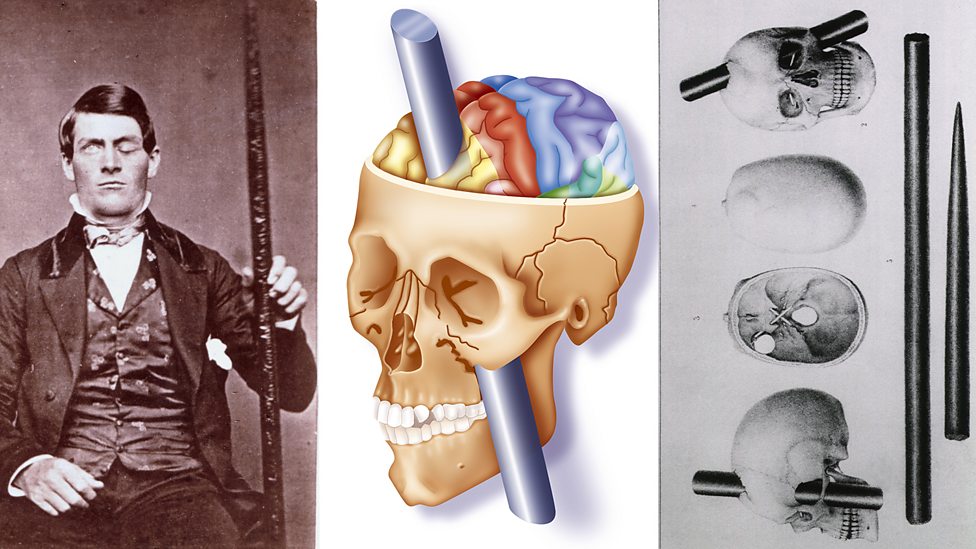 Harlow mentions neither Gage's sexual behaviour nor his drinking; nor is any documentation provided by any of those who have written on the matters. The prize for these kinds of fabrications must surely be shared between those accounts that endow him with sexual activity and those that turn him into a drunkard who dies in careless dissipation.
Harlow mentions neither Gage's sexual behaviour nor his drinking; nor is any documentation provided by any of those who have written on the matters. The prize for these kinds of fabrications must surely be shared between those accounts that endow him with sexual activity and those that turn him into a drunkard who dies in careless dissipation.
With the exception of a very small stock of additional facts uncovered by Dr. Fred Barker, Matthew L. Lena, Jack and Beverly Wilgus, and myself little has been added to what Harlow told us about Gage. What Harlow says may not be completely accurate. It is clearly influenced by his medical and phrenological ideas and is not specific about the period of Phineas' post-accident life to which it is meant to apply. But it is virtually all that we have. The story Harlow tells is tragic enough: it has no need for the addition of modern undocumented and contradictory fabrications.
What Phineas’ story does need is to be filled out with descriptions by people who actually saw him and described what he did and how he behaved. Most families and genealogists have old documents such as letters and diaries written by great-great-great grandparents and other ancestors and it is these that will contain such descriptions. The Questions page has a list of things for which answers are needed about Phineas when he lived in New England, Chile, and San Francisco.
Most families and genealogists have old documents such as letters and diaries written by great-great-great grandparents and other ancestors and it is these that will contain such descriptions. The Questions page has a list of things for which answers are needed about Phineas when he lived in New England, Chile, and San Francisco.
The Curious Case of Phineas Gage's Brain : Shots
The Curious Case of Phineas Gage's Brain : Shots - Health News In 1848, a railroad worker survived an accident that drove a 13-pound iron bar through his head. The injury changed his personality, and our understanding of the brain.
Your Health
Heard on Weekend Edition Sunday
Why Brain Scientists Are Still Obsessed With The Curious Case Of Phineas Gage
Cabinet-card portrait of brain-injury survivor Phineas Gage (1823–1860), shown holding the tamping iron that injured him. Wikimedia hide caption
Wikimedia hide caption
toggle caption
Wikimedia
Cabinet-card portrait of brain-injury survivor Phineas Gage (1823–1860), shown holding the tamping iron that injured him.
Wikimedia
It took an explosion and 13 pounds of iron to usher in the modern era of neuroscience.
In 1848, a 25-year-old railroad worker named Phineas Gage was blowing up rocks to clear the way for a new rail line in Cavendish, Vt. He would drill a hole, place an explosive charge, then pack in sand using a 13-pound metal bar known as a tamping iron.
But in this instance, the metal bar created a spark that touched off the charge. That, in turn, "drove this tamping iron up and out of the hole, through his left cheek, behind his eye socket, and out of the top of his head," says Jack Van Horn, an associate professor of neurology at the Keck School of Medicine at the University of Southern California.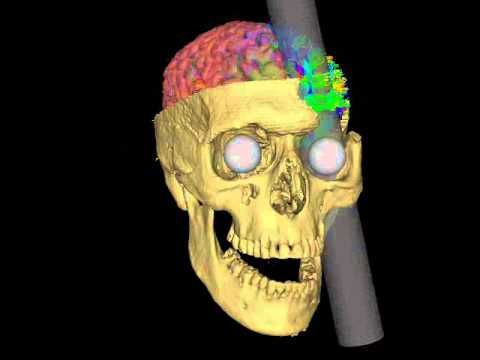
Gage didn't die. But the tamping iron destroyed much of his brain's left frontal lobe, and Gage's once even-tempered personality changed dramatically.
"He is fitful, irreverent, indulging at times in the grossest profanity, which was not previously his custom," wrote John Martyn Harlow, the physician who treated Gage after the accident.
This sudden personality transformation is why Gage shows up in so many medical textbooks, says Malcolm Macmillan, an honorary professor at the Melbourne School of Psychological Sciences and the author of An Odd Kind of Fame: Stories of Phineas Gage.
"He was the first case where you could say fairly definitely that injury to the brain produced some kind of change in personality," Macmillan says.
And that was a big deal in the mid-1800s, when the brain's purpose and inner workings were largely a mystery. At the time, phrenologists were still assessing people's personalities by measuring bumps on their skull.
Gage's famous case would help establish brain science as a field, says Allan Ropper, a neurologist at Harvard Medical School and Brigham and Women's Hospital.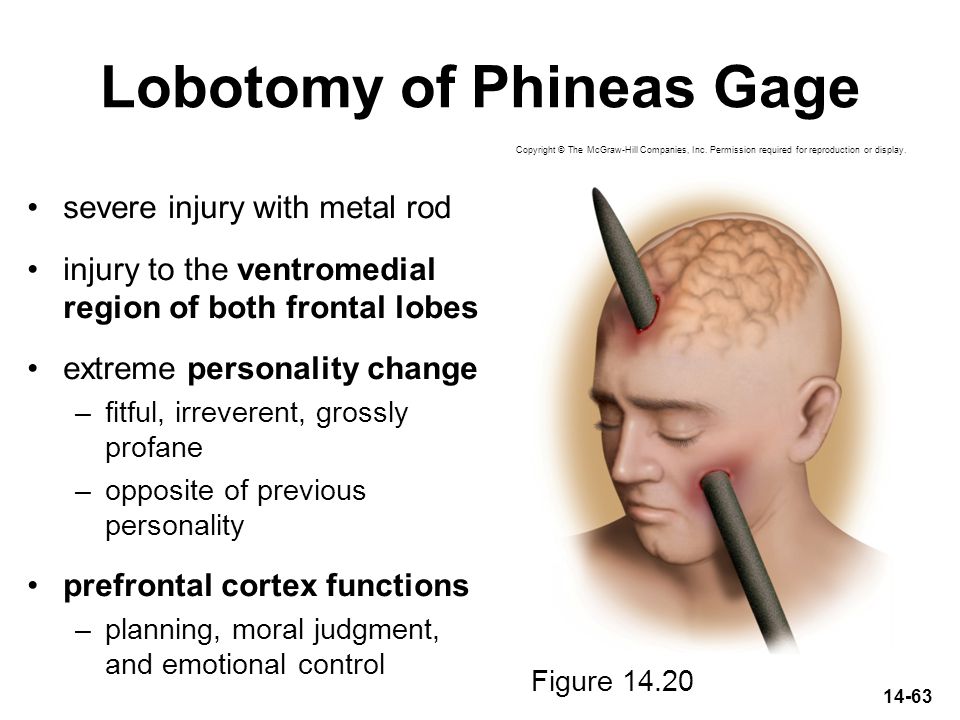
Dr. John Harlow, who treated Gage following the accident, noted his personality change in an 1851 edition of the American Phrenological Journal and Repository of Science.
The American Phrenological Journal and Repository of Science, Literature and General Intelligence, Volumes 13-14
The American Phrenological Journal and Repository of Science, Literature and General Intelligence, Volumes 13-14
"If you talk about hard core neurology and the relationship between structural damage to the brain and particular changes in behavior, this is ground zero," Ropper says. It was an ideal case because "it's one region [of the brain], it's really obvious, and the changes in personality were stunning."
So, perhaps it's not surprising that every generation of brain scientists seems compelled to revisit Gage's case.
For example:
- In the 1940s, a famous neurologist named Stanley Cobb diagrammed the skull in an effort to determine the exact path of the tamping iron.
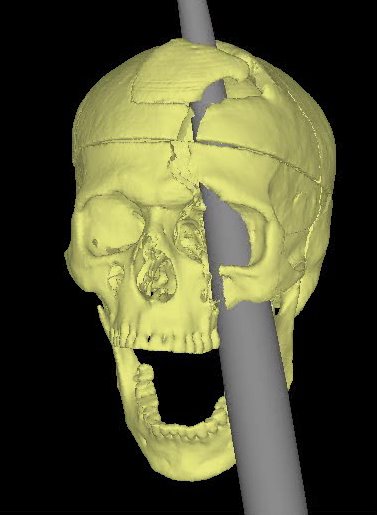
- In the 1980s, scientists repeated the exercise using CT scans.
- In the 1990s, researchers applied 3-D computer modeling to the problem.
And, in 2012, Van Horn led a team that combined CT scans of Gage's skull with MRI scans of typical brains to show how the wiring of Gage's brain could have been affected.
"Neuroscientists like to always go back and say, 'we're relating our work in the present day to these older famous cases which really defined the field,' " Van Horn says.
And it's not just researchers who keep coming back to Gage. Medical and psychology students still learn his story. And neurosurgeons and neurologists still sometimes reference Gage when assessing certain patients, Van Horn says.
"Every six months or so you'll see something like that, where somebody has been shot in the head with an arrow, or falls off a ladder and lands on a piece of rebar," Van Horn says. "So you do have these modern kind of Phineas Gage-like cases.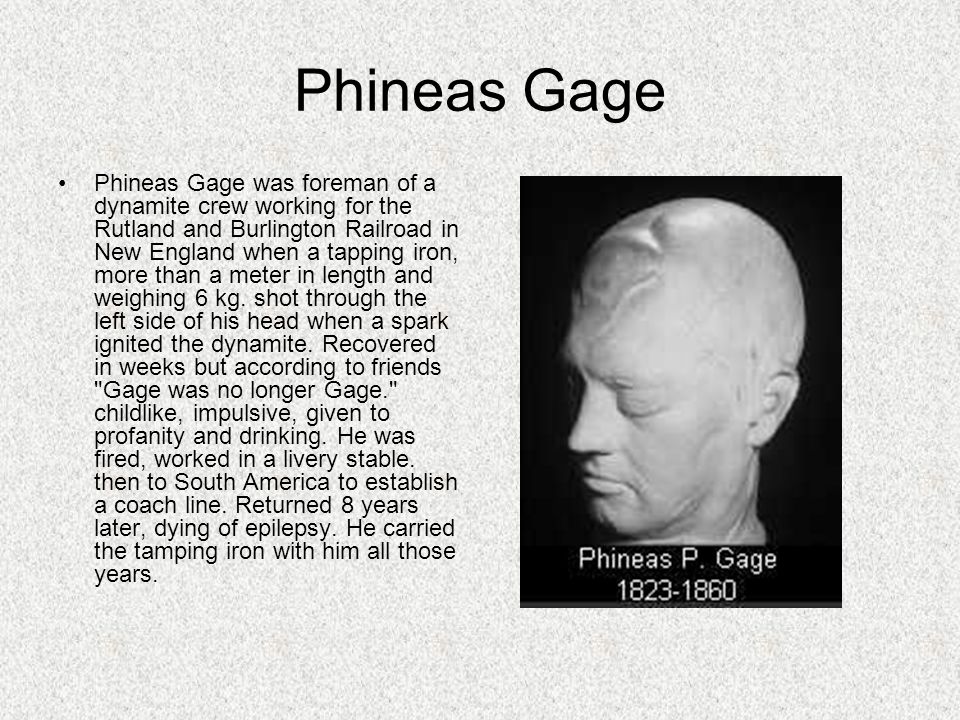 "
"
Two renderings of Gage's skull show the likely path of the iron rod and the nerve fibers that were probably damaged as it passed through. Van Horn JD, Irimia A, Torgerson CM, Chambers MC, Kikinis R, et al./Wikimedia hide caption
toggle caption
Van Horn JD, Irimia A, Torgerson CM, Chambers MC, Kikinis R, et al./Wikimedia
Two renderings of Gage's skull show the likely path of the iron rod and the nerve fibers that were probably damaged as it passed through.
Van Horn JD, Irimia A, Torgerson CM, Chambers MC, Kikinis R, et al./Wikimedia
There is something about Gage that most people don't know, Macmillan says. "That personality change, which undoubtedly occurred, did not last much longer than about two to three years. "
"
Gage went on to work as a long-distance stagecoach driver in Chile, a job that required considerable planning skills and focus, Macmillan says.
This chapter of Gage's life offers a powerful message for present day patients, he says. "Even in cases of massive brain damage and massive incapacity, rehabilitation is always possible."
Gage lived for a dozen years after his accident. But ultimately, the brain damage he'd sustained probably led to his death.
He died on May 21, 1860, of an epileptic seizure that was almost certainly related to his brain injury.
Gage's skull, and the tamping iron that passed through it, are on display at the Warren Anatomical Museum in Boston, Mass.
Sponsor Message
Become an NPR sponsor
The Curious Case of Phineas Gage and the Metal Rod in His Head / Neurology
In September 1848, , the life of a young railroad foreman was turned upside down after a terrible accident at work .
At the time, his job was to fly over rocks with explosives to make way for railroad tracks, and he had to put gunpowder and sand into a hole drilled in the rock.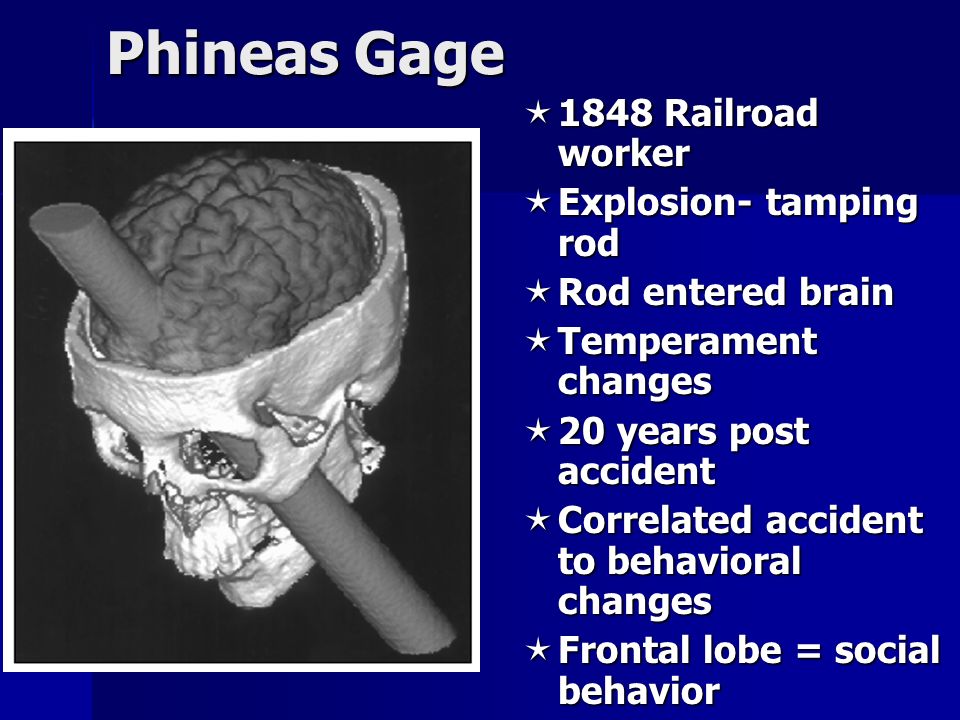
Phineas Gage: case study
Unfortunately, an error in procedure meant that when this worker tried to compress the powder placed in the cavity using a metal rod, a spark jumped. The explosion of the mixture occurred a few centimeters from the face of the young man and, as a result, a metal rod one meter long and three centimeters in diameter pierced his skull before landing more than twenty meters from where it was originally.
Phineas Gage as that was the worker's name, he regained consciousness a few minutes later with a hole that ran diagonally from one of his cheeks to the top of his head just above his forehead. Most of his frontal lobes ceased to exist as such. However, not only did Phineas Gage survive the experience, he was able to regain most of his mental abilities and went down in history as one of the most studied cases in the fields of psychology, medicine, and neuroscience..
Dr. Harlow and the medical miracle
Almost all we know about Phineas Gage is that he documented him Dr. Harlow , the doctor who treated him. This healthcare worker was impressed by the fact that Gage was conscious and able to speak when he entered his office, but he was more surprised that his patient recovered within a few months of arriving after going through a stage of fever and delirium.
Harlow , the doctor who treated him. This healthcare worker was impressed by the fact that Gage was conscious and able to speak when he entered his office, but he was more surprised that his patient recovered within a few months of arriving after going through a stage of fever and delirium.
So after only 10 weeks, Gage's brain function seemed to recover almost automatically , as if the cellular tissues of the brain were able to reorganize to compensate for the absence of a few cubic centimeters of the frontal lobe. However, Dr. Harlow was struck by something else: although objectively the master did not seem to have a significant mental or motor deficit, his personality seemed to have changed as a result of the accident. Phineas Gage was not quite the same.
New Phineas Gage
When Gage returned to work at the construction site, the measured and warm-hearted worker everyone knew disappeared to make way for a man with a bad temper, easily annoyed , given insults, prone to waste and a very short-sighted outlook on life. In general, he was an impatient and irreverent person who allowed himself to be carried away by desires born of whims and thought little of others. next to the metal rod that pierced his head. In later years, he lived in Chile, where he worked as a horse-drawn cart driver until he returned to the United States, feeling spoiled and somewhat ill. there he had his first epileptic seizures which accompanied him until his death in 1860 .
In general, he was an impatient and irreverent person who allowed himself to be carried away by desires born of whims and thought little of others. next to the metal rod that pierced his head. In later years, he lived in Chile, where he worked as a horse-drawn cart driver until he returned to the United States, feeling spoiled and somewhat ill. there he had his first epileptic seizures which accompanied him until his death in 1860 .
Why is the Phineas Gage case relevant?
This little piece of history is a must-stop in many neuroscience and behavioral university professions because it was, in fact, one of the first well-documented examples of how material changes in the brain change not only cognition but and aspects of psychology that are traditionally associated with the "soul", i.e., to the being and essence of man .
There is a theory that Phineas Gage turned out to be a different person, not through learning or self-reflection, but as a result of a very specific accident that physically changed his brain.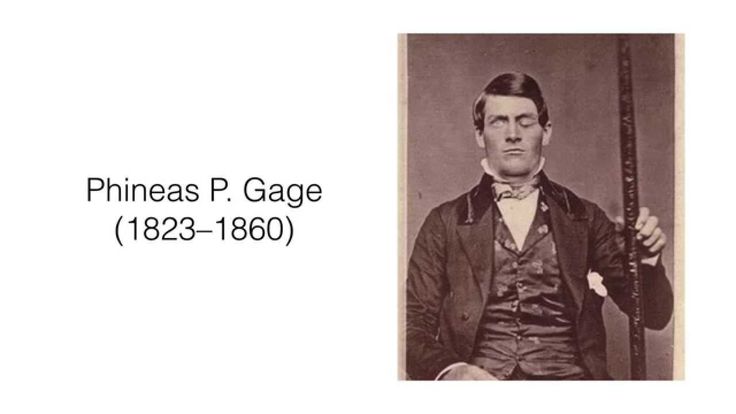 What was later proven could be an example of how the brain reorganizes itself to make up for the material deficit caused by the explosion from the most limited resources available to it, but the side effects of this were noted in aspects that were thought to be not so affected. material world, such as memory. nine0005
What was later proven could be an example of how the brain reorganizes itself to make up for the material deficit caused by the explosion from the most limited resources available to it, but the side effects of this were noted in aspects that were thought to be not so affected. material world, such as memory. nine0005
For some reason, an accident with a metal rod served as a signal the biological foundations on which rather abstract psychological processes are based, such as controlling emotions and making decisions. In addition, the case of Phineas Gage also supported the hypothesis that different areas of the brain deal with different aspects of behavior.
Possible prefrontal syndrome?
It is now believed that Phineas Gage's personality change may actually be an example of prefrontal syndrome, arose as a result of a change in the functioning of the frontal lobes . The frontal part of the brain plays an important role in linking current motives to future goals, which includes the ability to set long-term goals, the ability to forego immediate rewards in favor of more ambitious projects, and the ability to consider the consequences of actions themselves for those around us and society as a whole.
This would explain that the new behavior of the Phineas Cell, which suffered an accident with a metal rod, resembled in some aspects of the repertoire of behavior expected of someone with a psychopathic personality. Psychopaths also seem to show neuronal firing dynamics in the frontal lobes that are different from the rest of the population, but in Gage's case this would be caused by neuronal reorganization after brain damage.
Another possible explanation for the case that brain injury was the primary cause of Phineas Gage's personality change is widely accepted, but there is another alternative explanation: the change was due to the social consequences of the disfigurement..
As Zbigniew Kotowicz points out, it is highly likely that at least part of his behavioral changes were due to the social impact of others perceiving him as a person missing part of his brain. As always, It is difficult to separate the biological aspects from the socio-cultural ones.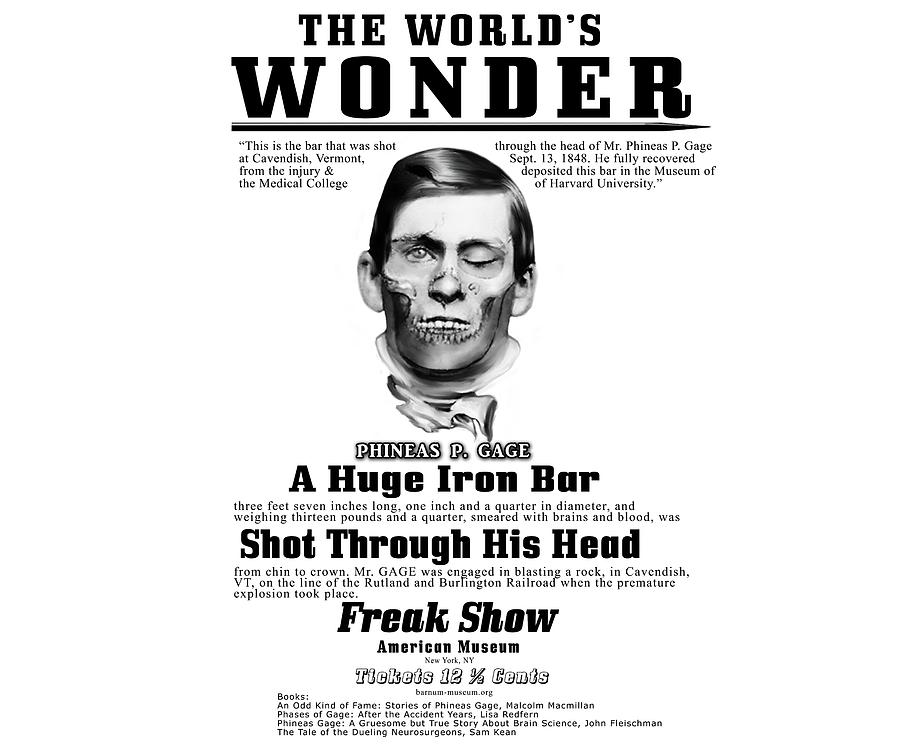 , and I was able to tell that Gage had what happened to Dr. Frankenstein's monster in Mary Shelley's novel: that it was society, not his own nature, that turned him into a strange body. nine0005
, and I was able to tell that Gage had what happened to Dr. Frankenstein's monster in Mary Shelley's novel: that it was society, not his own nature, that turned him into a strange body. nine0005
📖 "No More Gage", The Man Who Lived with a Hole in His Head: The Story of Phineas Gage. Classic cases in psychology. Rolls D. Page 71. Read online
...
Dr. Harlow reported that Phineas was able to perform all the tasks he performed before the accident, although some oddities were observed. Dr. Harlow began to worry about the mental state of his patient. Six months after the injury, Phineas returned to his employers to get a job. His physical abilities appeared to have recovered, his speech was correct, and his memory remained intact. Although many reports claimed that Phineas made a full physical recovery, there were still reports of his physical handicap. However, much more noticeable was the change in Phineas's character: he became impatient, aggressive and rude; he began to use obscene language and constantly changed his plans. He did not tolerate any objections and easily took unjustified risks. In this state, he could not inspire confidence, and his doctor and friends said of him that he was "not Gage anymore." No exhortation or reason could make him behave otherwise; apparently, he could not change his aggressive and unpredictable behavior, even though it adversely reflected on his life. After the end of the probationary period, the employers had no choice but to refuse the services of Phineas. nine0005
He did not tolerate any objections and easily took unjustified risks. In this state, he could not inspire confidence, and his doctor and friends said of him that he was "not Gage anymore." No exhortation or reason could make him behave otherwise; apparently, he could not change his aggressive and unpredictable behavior, even though it adversely reflected on his life. After the end of the probationary period, the employers had no choice but to refuse the services of Phineas. nine0005
In the meantime, his case has attracted the attention of other medical professionals, including Dr. Bigelow of Harvard University in Boston, Massachusetts. Baigelow invited Phineas to come to Harvard for a thorough examination. At that time, there were no well-established ways to study the brain, and doctors were just trying to figure out how it works. A case like that of Phineas was one of the opportunities to study the workings of the brain. In those days, there were two main scientific schools that had their own views on how the brain works.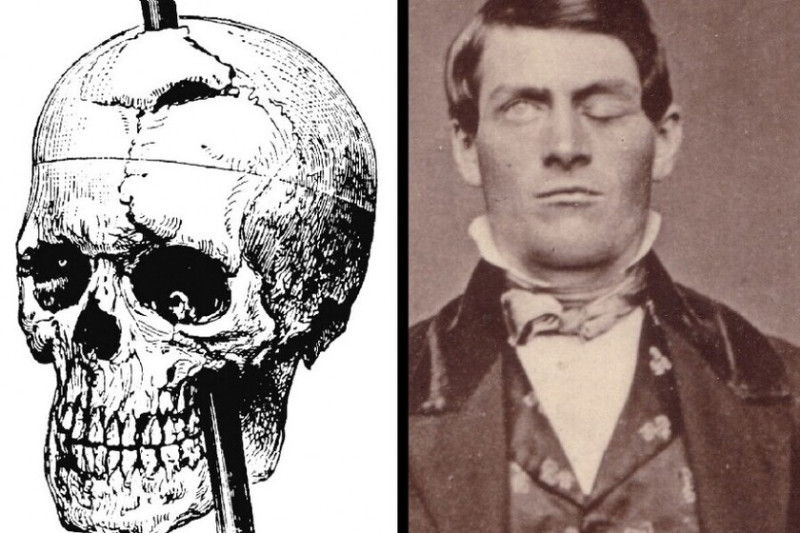 Some scientists, like Dr. Bigelow, believed that the whole brain controlled the thinking and behavior of a person, and that damage to one part of the brain would cause other parts of the brain to try to compensate for the weakening of its capabilities. nine0005
Some scientists, like Dr. Bigelow, believed that the whole brain controlled the thinking and behavior of a person, and that damage to one part of the brain would cause other parts of the brain to try to compensate for the weakening of its capabilities. nine0005
Representatives of the competing school adhered to the concept of the so-called localization of brain function (Dr. Harlow agreed with it). This concept assumed that specific areas of the brain had specific functions, and that damage to one area resulted in impairment of the corresponding mental or behavioral functions. The “science” of phrenology, which was emerging in those years, supported this point of view and tried to give its visual display using phrenological models of skulls. (The phrenological paradigm was widely used in the 19th century to explain the functioning of the brain. The functions of each part of the brain were determined by studying the external characteristics of the skull. The bulges and depressions on the skull were associated with the characteristics of the character of its owner and, thus, a “mental map” of the brain was drawn.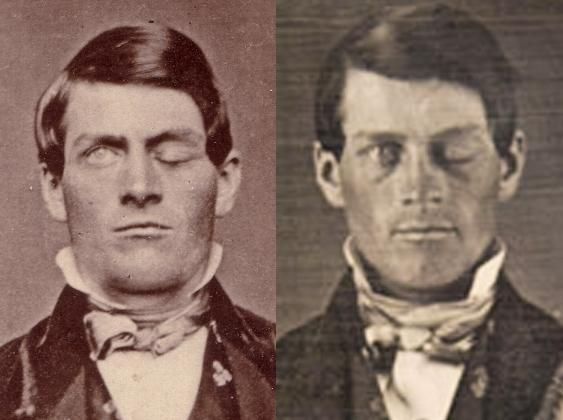 The phrenological concept is especially women liked it: since it was impossible to find fundamental differences between the skulls of men and women, this fact helped women in their struggle for equality with men.)
The phrenological concept is especially women liked it: since it was impossible to find fundamental differences between the skulls of men and women, this fact helped women in their struggle for equality with men.)
Supporters of both schools have taken an understandable interest in all cases like that of Phineas Gage. Physicians have not often been given the opportunity to study the consequences of such severe damage to the frontal lobes of the brain. In almost all cases, people who received such injuries died. As often happens in disputes between scientific schools, the case of Gage began to be interpreted by supporters of each of the schools as confirming the correctness of their views. On the one hand, it was argued that other areas of Phineas' brain took over the functions of the damaged areas, since otherwise the victim would either die or experience deeper consequences of his injury and probably could not reason correctly, control his movements, talk, etc. Gage's case has also been cited to support the idea that the brain is a whole complex organ that works as a single mechanism, and that it has an innate flexibility that allows undamaged areas to perform the functions of damaged ones. Dr. Baigelow believed these notions were correct and may have deliberately underestimated the nature of Gage's post-accident changes in order to support his point. nine0005
Dr. Baigelow believed these notions were correct and may have deliberately underestimated the nature of Gage's post-accident changes in order to support his point. nine0005
Aware of the need to keep sensitive patient information confidential, Dr. Harlow told a few trusted colleagues that Phineas was different from what he used to be. This was taken as evidence that the damaged areas of the brain were responsible for specific mental and behavioral functions that were now apparently lost. Their loss manifested itself mainly in the deterioration of the abilities for planning and logical reasoning, and in the general disinhibition of feelings for other people, which manifested itself in a lack of respect and the use of rude expressions. Quite coincidentally, the phrenological model placed the areas of "benevolence" and "pleasantness" in almost exactly the place that was damaged in Phineas. Thus, phrenologists and those who believed in the localization of brain function also began to view the case of Gage as confirming the correctness of their views. Since Harlow did not speak publicly of Gage's change of character until many years after his death, Bigelow's account of the incident was considered the most reliable, although it stated that the accident had little effect on Gage. nine0005
Since Harlow did not speak publicly of Gage's change of character until many years after his death, Bigelow's account of the incident was considered the most reliable, although it stated that the accident had little effect on Gage. nine0005
A curious feature of this story is that the same information can be used to validate the ideas of both competing schools of thought. However, assessing the past against current knowledge, it is not surprising that both groups used the Gage case to reinforce their ideas, and each was right in its own way. We now know that the brain is an extremely complex interconnected organ that contains 100 billion neurons, but does not work as a whole. Perhaps it would be more correct to imagine separate chains working together in our brain, but simultaneously performing their specific functions. Even functions that are localized in specific parts of the brain (for example, the functions of recognizing faces or recalling names) are interconnected with other areas.